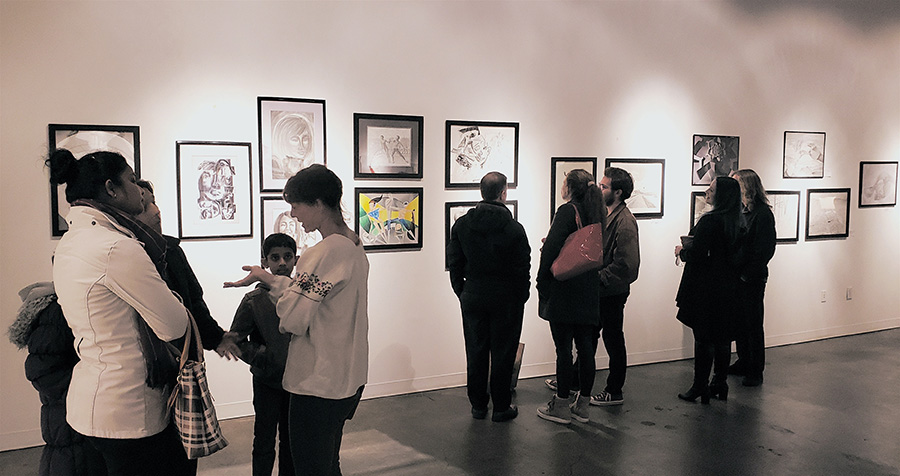 Visitors consider the artwork created by students in Francesco Fedele's Visual Arts and Geometry course at the Kai Lin Gallery Dec. 11. The drawings hung for one night at the gallery to celebrate the students' work in the class, which connected advanced geometry with art through the lenses of Einstein and Picasso. |
There aren’t many engineering courses that include, as the final class activity, exhibiting artwork at a local gallery.
Francesco Fedele’s students did just that Dec. 11, showing the drawings they created during his course this fall connecting advanced geometry with art through the lenses of Einstein and Picasso.
“They are icons of contemporary art and science,” and they were linked in time and ideas, Fedele said. “Einstein was an artist; Picasso was influenced by ideas about the fourth dimension, space and time.”
The course included students from computer science and across the College of Engineering and introduced what Fedele called exotic and complex concepts that don’t typical show up in the engineering curriculum — differential geometry, covariant derivatives and the like. Fedele showed how Einstein used the concepts as he was developing his theories of general and special relativity.
“My main goal was to expose the students to this difficult mathematical concept of differential geometry, and also, I want them to realize that special relativity and general relativity, they are not far away from us,” Fedele said, noting it has only been a century since Einstein’s paper on general relativity published in 1915.
“We need to appreciate it and understand it. The GPS navigation system we use every day on our phones would not work without Einstein’s relativistic corrections. It is not difficult to understand Einstein’s great physical insights on relativity of space and time; it is just that we think that everything is absolute in the world around us.”
That’s where art and Picasso come in. With a grant from Georgia Tech’s Ferst Center for the Arts, Fedele brought in Atlanta artist Emily Vickers to teach studio sessions and help students “unlock” their minds. The resulting artwork hung for an evening at the Kai Lin Gallery on Atlanta’s Westside at a public exhibition.
Powered by flickr embed.
“It’s very difficult to unlock your mind, but that’s what you have to do to understand Einstein. You need to give up on the idea that space and time are absolute,” said Fedele, an associate professor in the School of Civil and Environmental Engineering. “Artists can do that. They are free-thinking; they are unlocked.”
It was the first time Fedele taught the course and likely just as difficult for him as for his students, he said. But he saw how exploring Picasso and Einstein’s insights on relativity and cubism, art and science opened students’ eyes.
“Emily and I saw the evolution in their thinking and drawing skills over the semester. Some of them started very locked in their mind and even very rigid in the way they were holding the pencil,” Fedele said. “In three months, they basically freed their style, and they started to appreciate these concepts. We can see it.”
Fedele and Vickers ended the class with an exhibition simply because, Fedele said, they wanted their students to be proud of what they accomplished over the semester. Fedele also wanted to connect with Atlanta’s art community so that he can find more ways to link local artists with Tech, perhaps even through an artist-in-residence program.
At a minimum, he’s planning to teach his Visual Arts and Geometry course again next year to engage a new group of students
“To me, the future of education has to be art and science. There is not much difference; artists are like scientists, they are thinkers,” Fedele said.
“Each of us, we are all artists. If you put forth the dedication to learn the skills, it will come. We are born to create. The caveman didn’t even talk, and he was creating graffiti.”
Walk through the exhibit in this short video from Francesco Fedele:
